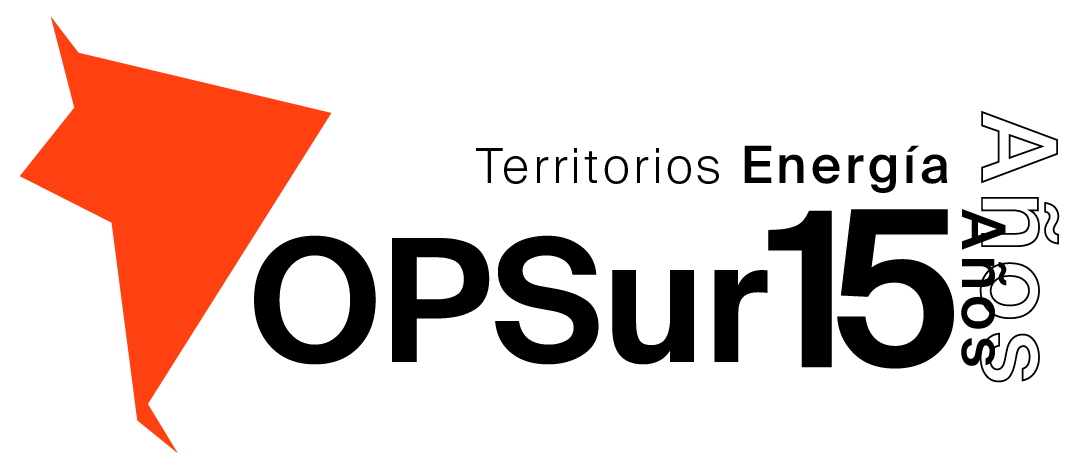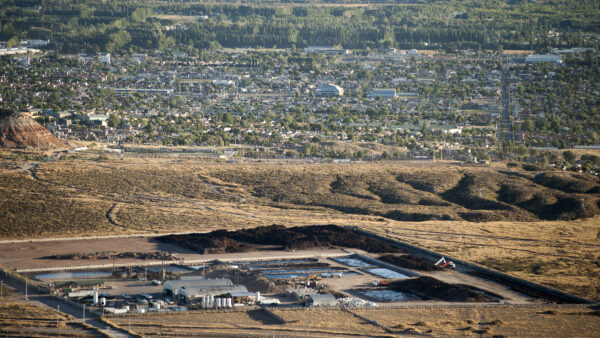When the people of Cerro Alto found out that the Chinese company Envision Energy was going to set up a wind farm, the first question that the Mapuche and criollo families asked was if the electricity generated would reach their homes. In that rural area of the Río Negro province, close to the touristy Bariloche, access to energy is insufficient and expensive. Many of its dwellers have already been displaced by the construction of hydroelectric plants on the Limay river, and they watch from their homes how the high voltage towers and the gas pipelines bring the energy somewhere else. The growth of generation from renewable sources changed energy production and distribution logics, making it more of an exclusion-generating model than a democratizing tool.
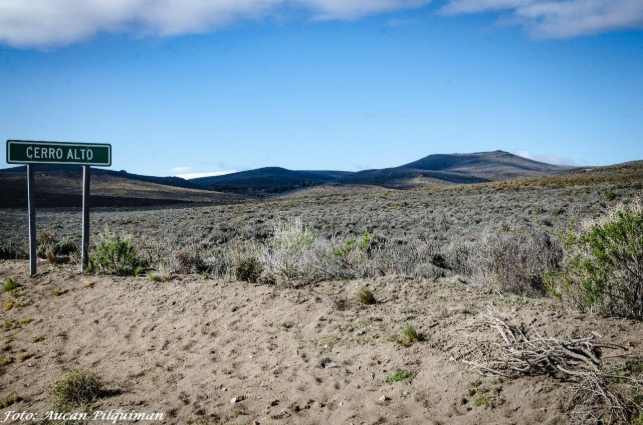
By OPSur.- In the first round of the RenovAr Plan bidding process, celebrated in 2016, the Cerro Alto wind power project (in Río Negro) was awarded to the Chinese company Envision Energy. Adyacent to Pilcaniyeu, 60 km to the east of Bariloche, the project would install 28 wind turbines inside Estancia Futa Mahuida, which includes the Cerro Alto, a hill that gives the area its name and is particularly relevant for the Mapuche worldview, in this case, for the Wefu Wechu community. The wind power plant would be located in a space of 1,600 hectares and have an installed capacity of 50 MW. The totality of the production would be injected to the Argentine Interconnection System (SADI). The 150 families living in the area, distributed in the Cerro Alto, Coquelen, Corralito, Melico, and Panquehuau localities, have had a historically deficient access to energy. Traditionally, they rely on firewood and gas cylinders, and many families have generators. Others have no electricity at all.
The project’s Environmental Impact Study was approved in 2011 in a process that did not include the participation of those who inhabit the area. According to Luis Pilquimán, werken (spokesman) of the Lef Wefu Wechu, they heard about the wind farm no earlier that 2017. “We found out about the project indirectly, and almost by chance, in a meeting with the provincial government. They presented it as an achievement, but the first thing people asked was if some of the electricity was going to be left for the rural population. We heard about it by pure chance.” In response, the community demanded that a consultation process and a cultural impact report be carried out by the provincial government. They also opened up spaces of dialogue with Envision Energy and the Inter-American Development Bank (IDB), co-financer of the project.
The area has a recent memory of the dispossession brought about by other energy enterprises. The Cerro Alto site is 30 km from Alicurá and 80 km from Piedra del Águila, two of the five hydroelectric plants installed on the Limay river, which generate 41% of the country’s hydropower. The building of the dams began in the 70s and was completed in the 90s. The Piedra del Águila reservoir flooded 281,647 hectares and affected the territories of two communities. In the Pilcaniyeu Indigenous Reservation on the Limay, 125 people had to be re-located. The works also had negative impacts on different productive and cultural activities that were not taken into account by the state-run company Hidronor at that point (Balazote and Radovich, 2003).
Connected to those power plants was the Alicura-Pilcaniyeu-Bariloche High Voltage Transmission Line, built in 1986, when the gas pipeline Cordillerano was also inaugurate. The power lines and the gas pipeline cross the territory where the Cerro Alto wind farm is to be installed, and they are part of the landscape. “Of the families that are now being affected by the wind farm, many were previously displaced by the construction of the dams on the Limay river. And what we see is that none of these dams generate energy for the local people. They only affect us negatively, destroying our fields, there are no benefits. But this happened decades ago. Now the people, the organized communities, take a stance, things are different,” states Pilquimán.
The cultural impact report drafted by a team from the National University of Río Negro provides details about the potential impacts of the wind power project, such as the disruption of livelihoods of local communities and their productive practices, and the potential modification of cultural elements like archeological and ceremonial sites (in the case of the Cerro Alto hill), and mentions the lack of information regarding the potential sound and shadow impacts of the project once it beings operating. “It seems that these megaprojects are always causing social conflicts. This is not always due to the project itself in all cases, but to the fact that in its implementation the civil and social rights of the adjacent populations are ignored,” stated the community in a communiqué. “We understand that wind power is among the least polluting sources, but nonetheless it does imply a level of contamination. So, we seek to develop organizing processes where debate and analyses of these projects are possible,” added Pilquimán.
The right to free, prior, and informed consent has been won by indigenous peoples based on the fact that they predate the formation of the Argentine State. This right came into force in 2011, a year after the 169 ILO Convention was ratified. However, it is rarely observed in practice, thus denounces, repression, and displacements multiply in the territories claimed by indigenous communities. But that was not the case in this project. In April 2018, the provincial government, together with the National Institute for Indigenous Affairs (INAI), convened a round table with participation of the community, representatives of different localities, the company and the State. At that time, the community stated that “the Consultation process is not a rejection of the project but the exercise of the right to know, understand, and assess the proposal to be able to evaluate both its positive and negative impacts on the community and the lives of the residents of the affected localities. The State has to be the guarantor of the right that, in this case, we are exercising.”
However, in October 2018, Envision Energy cancelled the project and relocated it to the province of Neuquén. Following the project’s cancellation, Claudio Andrade, Clarín journalist, published an article titled “Tension in the south. Mapuche conflict leads to cancellation of investments in energy project in Río Negro,” where he claims—using uncited sources—that the company reached that decision as a result of extorsions from the community and the high costs of having to pass a voltage line to the sector. Pilquimán, the current vice-president of INAI, denies that version, explaining that the article was published against the backdrop of a political stigmatization of the Mapuche People of which Andrade was part, and asserts that “it has absolutely nothing to do with the actual facts.” He adds, “We believe that the company left due to the economic adjustment in the country. We have discussed this with provincial delegates, and they do not know the reasons either. We have never talked about any kind of amount or compensation, we did not get to that point.”
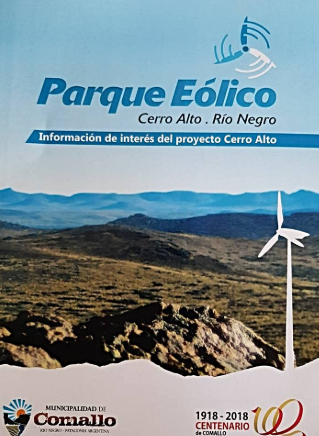
The Meanders
The Cerro Alto wind farm project was absorbed by the Parque Eólico Los Meandros (Meanders Wind Farm), located in Challacó (Neuquén). With that merge, the Neuquén farm was expanded, from 75 MW to 125 MW. Should it become a reality, it would be the plant with the largest installed capacity projected in the province, and one of the biggest in the country, with an estimated investment of USD 180 million. Works were initiated in mid-February 2019, and the Chinese company asserted back then that commissioning would be possible in February 2020, but that did not happen. In the first edition of the RenovAr plan, Envision Energy presented four projects (P. E. García del Río, P. E. Vientos del Secano, P. E. Cerro Alto and P. E. Los Meandros), with a total of 185 MW, accounting for more that 26% of the total capacity awarded in that round. Four years after the licensing round, only the García del Río wind farm, of 10 MW, is operational.
When works for Los Meandros project began, Envision Energy’s representative in Argentina, Javier Vázquez, stated that “the company is one of the biggest in the world, with a generation of 14,000 installed MW in wind farms in different countries” and stressed the positive impacts of the project in the local economy: 250 jobs during peak activity (civil works), going down to 20 after commissioning. Vázquez also asserted that they would work in collaboration with the technology hub that is under Plaza Huincul and Cutral Có jurisdictions, and announced the possibility of forming a cluster of service companies during construction and operation. Paradoxically, a few months later, in the inauguration of the García del Río wind farm, the press highlighted that it was due to a success in Chinese-Argentine diplomatic relations that the project had 100% Chinese investment and technology, that is, zero local technological development.
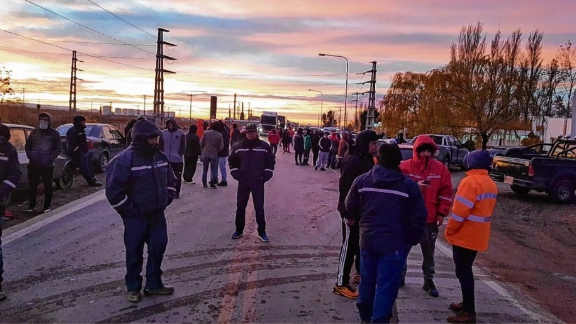
During the commencement of works for Los Meandros, Jorge Brillo, president of the Agency for Investment Development of Neuquén, underscored that projects like that “have promotional benefits in gross revenues, seals and property taxes, and land use in private or government-owned lands authorized by different government areas, with existing environmental approval.” That means that the way has been paved. However, in spite of the promotional advantages, in June 2019, workers of Enginer and Milicic, in charge of civil works, blocked National Route 22 in Plaza Huincul to protest the layoff of 150 workers after the project was halted. Back then, journalist Federico Aringoli, from the Río Negro newspaper, revealed some elements with regards to the interruption of civil works: “The provincial technicians seemed surprised after each national licensing round due to the low bidding prices, something was not falling into place. Los Meandros, bid by the Chinese giant Envision, was not the exception. It was awarded the project having made one of the lowest bids. The hypotheses were many: undervalued costs, real estate speculation and cheap external financing, among others. The perspective was not completely wrong, because the project never managed to meet the established timelines. It won some extra time after absorbing a similar wind farm in Río Negro and with contemplations from the National government. The new interruption in the project casts a shadow on the plan once again.”
Both Envision Energy and the provincial government claimed in mid-2019 that it was a temporary measure due to a financing problem related to the expansion of Los Meandros. Toward the end of November, when the company inaugurated the García del Río wind farm, 40 km from Bahía Blanca, representatives of the firm anticipated that the Vientos del Secano project (also located in Buenos Aires) would be commissioned in 2020. As to Los Meandros, they did not give an approximate date.
The works have been at a standstill for a year. According to Río Negro, during that time the province of Neuquén was in charge of solving “other setbacks” that could hamper the development of the project. Exploration permits were granted to a North American mining company but these were terminated, and the same thing happened with an oil company, which proves that when there is a political will, there is a way to limit extractivism. As the newspaper highlighted, “In addition to that, as it happened in Río Negro, an occupant of the area showed up, but the setback was immediately solved,” although it is not explained how. In an implicit and significant way, the newspaper questions the territorial rights of the Mapuche communities and the occupation rights of the local dwellers, further stigmatizing those who “show up” just to obtain benefits.
Wind power within a model of exclusion
More than 200 km from Cerro Alto, the recently inaugurated Vientos Neuquinos wind farm represented an important injection of electricity from renewable sources. However, its construction process involved the rejection and criminalization of the demands of the Cárdenas Rañileo family, who proved occupation of the lands where the farm was established for more than a century. In this case, as in Cerro Alto, elements such as the denial of rights and the lack of equal access makes the dwellers of the sites where energy is generated second-class people. Thus, projects that could generate cleaner energies, such as wind power, and are urgent and necessary in Argentina and the rest of the world, end up under the same logics implemented in hydrocarbon extraction sites.
Anthropologists Alejandro Balazote and Juan Carlos Radovich tell us how the construction of dams on the Limay river, in addition to causing flooding and displacements, deeply altered the local livelihood. The initial job promises vanished and gave way to higher costs of living and rent, the modification of roads (modes of moving through the territory), and productive practices. Once operation begins, the mass of workers migrates, and occupation becomes minimal. Investments come just as they leave: disinvestment is the other side of the story. The Vaca Muerta boom, in cities like Añelo, experiments similar cycles. The generation of renewable energies in the country has not yet reached a significant scale; it is critical to rethink the current logics and above all to include the local population so that it shares the benefits, not only the negative impacts. We must conceive of energy as a means to improve—through its access—the quality of life of the populations. Otherwise, renewables will be part of the problem, not of the solution.
References
Aringoli, F. “El sueño renovable entre la expectativa y la realidad”, Río Negro, 3/06/2019.
Balazote, A., & Radovich, J. C. (2003). Grandes represas hidroeléctricas: efectos sociales sobre poblaciones Mapuches en la Región del Comahue, Argentina. Hidrelétricas e Povos Indígenas. Florianópolis: Letras Contemporâneas, 85-109.
Del Pozzi, M. “Neuquén quiere acelerar su segundo parque eólico”, Río Negro, 14/06/2020.
Energía Estratégica, 15/02/2019, “Envision inicia las obras del parque eólico «Los Meandros» en Neuquén: se inauguraría en febrero de 2020”.
Kropff, L. (coord.) (2019). Informe de Impacto Cultural del Proyecto “Parque Eólico Cerro Alto”. Universidad Nacional de Río Negro.
Río Negro, 3/06/2019. “Nueva demora en el parque eólico Los Meandros puso en alerta a los trabajadores”.
Singh, N. “Envision inauguró el primer parque eólico en Argentina que cuenta con 100% de inversión y tecnología proveniente de China”, Energía Estratégica, 27/11/2019

